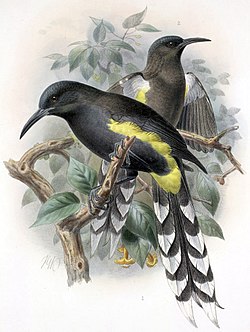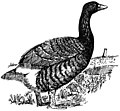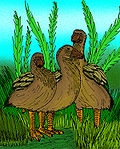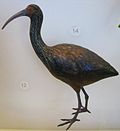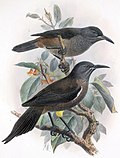| Common name | Scientific name | Range | Comments | Pictures |
|---|
| Oʻahu icterid-like gaper | Aidemedia chascax | Oahu | Prehistoric [21] | |
| Maui Nui icterid-like gaper | Aidemedia lutetiae | Maui and Molokai | |
| Sickle-billed gaper | Aidemedia zanclops | Oahu | |
| Oʻahu ʻakialoa | Akialoa ellisiana | Oahu | The species is known from only two specimens collected in 1837, although there were undocumented reports in 1937 and 1940. Thought to have been driven to extinction by habitat destruction and disease. [31] | 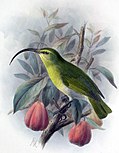 |
| Maui Nui ʻakialoa | Akialoa lanaiensis | Maui, Lanai and Molokai [32] | Named from three individuals collected on Lanai in 1892; fossils have also been found on Molokai and Maui. The species is thought to have been driven to extinction by habitat destruction, disease, and possibly introduced species. [32] | 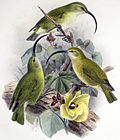 |
| Lesser ʻakialoa | Akialoa obscura | Hawaii (island) | Last reported in 1940. Likely extinct due to deforestation and introduced diseases. [33] |  |
| Kauaʻi ʻakialoa | Akialoa stejnegeri | Kauai | Last reported in 1969. Extinct due to forest clearance and introduced disease. [34] |  |
| Hoopoe-billed ʻakialoa | Akialoa upupirostris | Oahu and Kauai | Prehistoric [21] | |
| Giant ʻakialoa | Akialoa sp. | Hawaii (island) | |
| Akialoa sp. | Maui | |
| Kona grosbeak | Chloridops kona | Hawaii (island) | Restricted to about four square miles by the time of its discovery in the late 19th century, it was last collected in 1894. The reasons of extinction are unknown, but may include habitat destruction, introduced mammalian predators, and avian malaria. [35] |  |
| King Kong grosbeak | Chloridops regiskongi | Oahu | Prehistoric [21] | |
| Wahi grosbeak | Chloridops wahi | Maui and Oahu | Prehistoric. Might include the Kauaʻi grosbeak (Chloridops sp.). [21] | |
| Kauaʻi grosbeak | Chloridops sp. | Kauai | Prehistoric. Might be synonymous with the Wahi grosbeak (Chloridops wahi). [21] | |
| Maui grosbeak | Chloridops sp. | Maui | Prehistoric [21] | |
| ʻUla-ʻai-hawane | Ciridops anna | Hawaii (island) | Last collected in 1892, there was an unconfirmed sighting in 1937. The causes of extinction are unknown, but deforestation, malaria, and predation by introduced rats may have been contributing factors. [36] |  |
| Stout-legged finch | Ciridops tenax | Kauai | Known from subfossil remains. Likely extinct due to habitat destruction and hunting for feathers by Polynesians. [14] | |
| Molokaʻi ʻula-ʻai-hawane | Ciridops cf. anna | Molokai | Prehistoric [21] | |
| Oʻahu ʻula-ʻai-hawane | Ciridops sp. | Oahu | |
| Black mamo | Drepanis funerea | Maui and Molokai | Last collected in Molokai in 1907; fossils are known from Maui. It probably disappeared due to destruction of its understorey habitat by introduced cattle and deer, and predation by rats and mongooses. [37] |  |
| Hawaiʻi mamo | Drepanis pacifica | Hawaii (island) | Last recorded in 1898. Although heavily trapped for its feathers, it was likely driven to extinction ultimately by habitat destruction and disease. [38] |  |
| Lānaʻi hookbill | Dysmorodrepanis munroi | Lanai | Only known from a single specimen collected in 1913 and single sightings in 1916 and 1918. Presumably driven to extinction by clearing forests for pineapple plantation, predation by cats and rats. [39] | 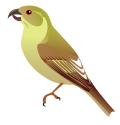 |
| Oʻahu nukupuʻu | Hemignathus lucidus | Oahu | The last two preserved individuals were collected either during an expedition in 1838 or another in 1840-1841, though native accounts suggest it was still present in 1860. A second-hand report from 1939 is "doubtlessly incorrect". [40] | 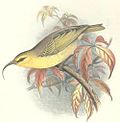 |
| Giant nukupuʻu | Hemignathus vorpalis | Hawaii (island) | Only known from fossils younger than c. 1000 BCE - 500 CE. [41] | |
| Laysan honeycreeper | Himatione fraithii | Laysan | Disappeared after almost the entire vegetation cover of the island was eaten by introduced feral rabbits. The last three individuals were killed in a storm in 1923. [42] |  |
| Kauaʻi palila | Loxioides kikuchi | Kauai | Known from two fossil jaws dated to 1375-1610 CE. [43] | |
| Oʻahu ʻakepa | Loxops wolstenholmei | Oahu | Last recorded in 1930. Probably driven to extinction by habitat destruction and disease. [44] |  |
| Poʻouli | Melamprosops phaeosoma | Maui | Last two individuals recorded in 2004; one died shortly after being captured. The precise causes of decline are unknown. Suggestions include habitat destruction and modification, spread of disease-carrying mosquitos, pig activity, predation by rats, cats, and small Indian mongooses; and the decline of native Hawaiian snails as a result of predation by rats and the garlic snail Oxychilus alliaricus . [45] |  |
| Highland finch | Orthiospiza howarthi | Maui | Prehistoric [21] | |
| Kākāwahie | Paroreomyza flammea | Molokai | Last recorded in 1961-1963. Presumed to have disappeared due to habitat destruction and disease. [46] |  |
| Lānaʻi ʻalauahio | Paroreomyza montana montana | Lanai | Extinct since 1937. [47] |  |
| Lesser koa finch | Rhodacanthis flaviceps | Hawaii (island) | Seemed to have been driven to extinction by habitat destruction, and not by climatic variation nor mosquito-vectored diseases. Koa finches were likely driven out of lowland habitat before or shortly after the time of western contact in 1778. The two species from the island of Hawaii persisted until the late 19th century, when their upland refugium was degraded by logging, ranching, and intensified predation by the black rat. [48] The lesser koa finch was last recorded in 1891. [49] According to the IUCN red list, "this or a similar species is also known from the fossil record of O'ahu and Maui" [49] apparently referring to the primitive koa finch (Rhodacanthis litotes). [50] |  |
| Scissor-billed koa finch | Rhodacanthis forfex | Maui and Kauai [50] | Known from fossils on Maui and Kauai. Based on its disjunct distribution, the species might have occurred on all main islands except the island of Hawaii, although more fossils are needed for confirmation. [50] The koa finches seem to have been driven to extinction by habitat destruction, and not by climatic variation nor mosquito-vectored diseases. Koa finches were likely driven out of lowland habitat before or shortly after the time of western contact in 1778. The two species from Maui might have survived in an upland refugium until the late 19th century, paralleling the fate of the two species from the island of Hawaii. However, the only verified records are from fossils at a lower elevation. [48] | |
| Primitive koa finch | Rhodacanthis litotes | Maui and Oahu [50] | Known from fossils on Maui and Oahu. Based on its disjunct distribution, the species might have occurred on all main islands except the island of Hawaii and perhaps Kauai, although more fossils are needed for confirmation. [50] The primitive koa finch populations from Oahu and Maui might represent two distinct species, but more fossils or genetic data are necessary. [50] The koa finches seem to have been driven to extinction by habitat destruction, and not by climatic variation nor mosquito-vectored diseases. Koa finches were likely driven out of lowland habitat before or shortly after the time of western contact in 1778. The two species from Maui might have survived in an upland refugium until the late 19th century, paralleling the fate of the two species from the island of Hawaii. However, the only verified records are from fossils at a lower elevation. [48] | |
| Greater koa finch | Rhodacanthis palmeri | Hawaii (island) | Last collected in 1896. The causes of extinction are unknown, but habitat destruction and introduced avian malaria are likely responsible. [51] |  |
| Kauaʻi finch | Telespiza persecutrix | Oahu and Kauai | Most recent remains were found in cave deposits dated to 1425-1660. [11] | |
| Maui Nui finch | Telespiza ypsilon | Maui and Molokai | Prehistoric [21] | |
| Maui finch | Telespiza cf. ypsilon | Maui | |
| Strange-billed finch | Vangulifer mirandus | Maui | |
| Thin-billed finch | Vangulifer neophasis | |
| Greater ʻamakihi | Viridonia sagittirostris | Wailuku River, Hawaii (island) | Last recorded in 1901. Its only known forest habitat was cleared to plant sugar cane. [52] |  |
| Cone-billed finch | Xestospiza conica | Kauai | Prehistoric [21] | |
| Ridge-billed finch | Xestospiza fastigialis | Oahu, Molokai, and Maui | |
| Drepanidini gen. et sp. indet. | Maui | At least three different species, all prehistoric. [21] | |
| Drepanidini gen. et sp. indet. | Oahu | Prehistoric [21] | |

